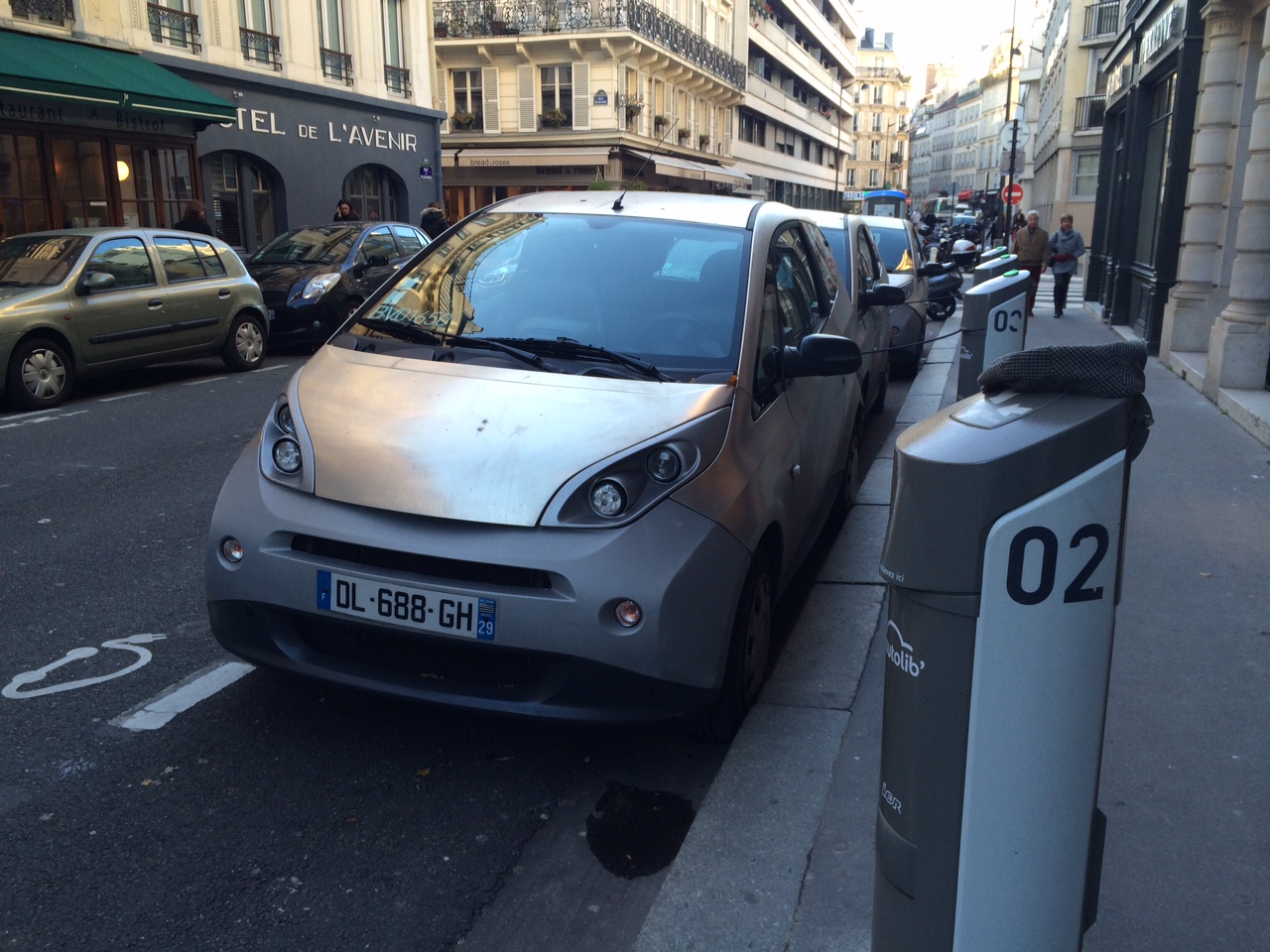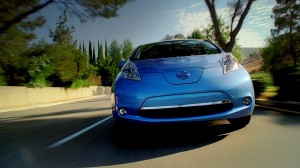You hear critics complain that electric vehicles are toys for the rich. Or that they’re not workable in dense, urban environments where residents don’t have access to dedicated parking for overnight charging. Paris is showing how both objections can be overcome.
When I went to Paris in 2014, I blogged about the great transit system and pedestrian and biking culture. I also promised to discuss their electromobility options, which I saw in effect again this past trip. It’s worth finally reporting on.
Basically, for a variety of fee options, anybody in Paris can have access to a network of electric vehicles parked in central locations around the city. It’s called Autolib, and here’s an example from 2014:
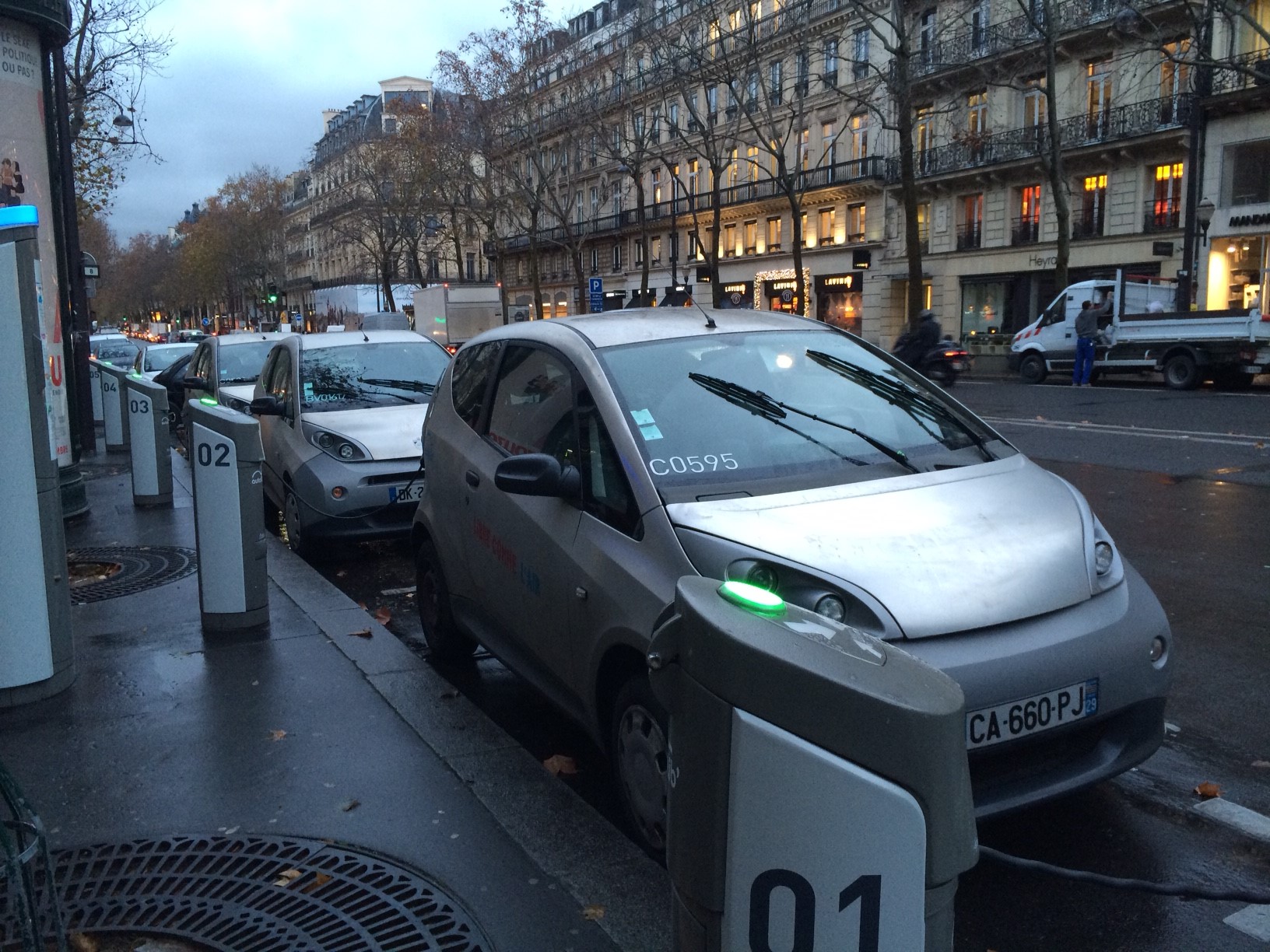 As you can see, Paris provides this car-charing network with dedicated on-street parking and charging. Residents just check out the car and then use GPS to return it to charge at the closest available parking bank.
As you can see, Paris provides this car-charing network with dedicated on-street parking and charging. Residents just check out the car and then use GPS to return it to charge at the closest available parking bank.
Costs aren’t bad, compared to the cost of owning a vehicle and parking spot in Paris, not to mention the hassle of trying to find a parking spot in the city. For example, if you needed to rent a vehicle for about an hour a week, it would cost about $15.
This model would be really useful in places like downtown Los Angeles, San Francisco, and New York City. And as more people want to live in those kinds of environments, services like Autolib provide a perfect low-pollution solution for when they need a car.
And here’s another photo from my most recent trip (I noticed the cars were dirtier this time, so maybe they need to build in a car-wash feature):
Pacific Gas & Electric is raring to go in California to install, operate, and maintain electric vehicle charging infrastructure, at ratepayer expense [PDF]:
PG&E proposes to deploy up to 25,000 level 2 charging stations and 100 DC fast chargers (DCFCs) at workplaces, multi-unit dwellings (MUDs), and at public or retail locations, which will help accelerate EV adoption and attainment of the state’s transportation and clean air goals.
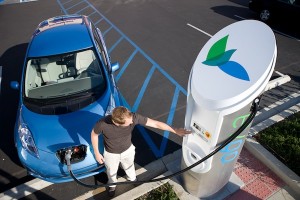 The utility’s effort is now supported by state law, with SB 350 (De Leon, 2015) specifically encouraging Big Utilities to take on Big Oil when it comes to transportation fueling.
The utility’s effort is now supported by state law, with SB 350 (De Leon, 2015) specifically encouraging Big Utilities to take on Big Oil when it comes to transportation fueling.
I’m generally in favor of allowing utilities to enter this space, given the strong and growing need for more infrastructure for the increasing number of plug-in vehicles. But I’m most heartened by this mention in the proposal:
PG&E is currently leading an EPIC-funded [California Energy Commission/Public Utilities Commission] project regarding DCFC [fast-charging] siting in collaboration with UC Davis, E3, and PlugShare. The research findings will develop a public tool to help site DCFC deployments based on forecast traffic demand and lowest utility distribution costs.
The state is long overdue for a better methodology on where to site fast chargers. Current locations are suboptimal, and there are still major corridors in the state that lack adequate chargers for short-range electric vehicle travel (for example, good luck driving your LEAF from San Jose to Monterey).
I’m pleased to see PG&E is part of this grant-funded effort, and hopefully their involvement in EV infrastructure will benefit the state’s EV, environmental, economic and equity goals.
Since I did the look-back on 2015 yesterday, now’s the time to offer the three big things to watch in 2016 on the fight to reduce greenhouse gas emissions:
3. Presidential Election: This is huge, as the current leading Republican candidate would say. The November election will determine whether the US sticks with the Paris agreement, continues support for renewable technologies and corresponding lack of support for coal, and fights for the EPA Clean Power Plan. The EPA finally released this plan in 2015, as required by a 2007 Supreme Court decision, and the plan underlies the US commitment to greenhouse gas reduction enshrined in the Paris agreement. While the final legal outcome won’t happen for a few more years (it will assuredly go to the Supreme Court), a Republican administration will try to gut the proposed rule from within.
2. Electric Vehicle Progress: As I mentioned yesterday, electric vehicle sales were down in 2015. But with the new Chevy Volt coming out, a slightly improved LEAF, and the much-hyped Tesla Model X all hitting the road, it will be important to see progress on the sales front this year. As a related honorable mention, we’ll need to see continued decreases in battery prices, not just for vehicles but for energy storage more generally.
1. California’s SB 32 2030 Climate Goals: The state has been an international leader fighting climate change, thanks to 2006’s AB 32, which set carbon reduction goals for 2020. But the effort to extend and ramp up the targets by 2030 failed spectacularly in the Assembly last year. It’s vital for the climate fight that the law pass this year. Otherwise, existing legal authorities to continue carbon reduction beyond 2020 are weak, and the signal a failure would send to the country and world would be detrimental. Meanwhile, the state would risk undermining the progress it has made nurturing in-state clean technology industries. While federal action on climate is important, California’s role as the guinea pig and pioneer on climate has been central to showing leaders in advanced economies how to decarbonize while growing the economy.
And with that, let’s see what the new year brings.
Happy 2016! With the new year here, I wanted to reflect on some of the big environmental accomplishments of 2015. Here are my top three best pieces of news on climate change:
3. Paris Climate Agreement: Sure, it was mostly political theater, with a non-enforceable international agreement that could be undermined as soon as next year by a Republican U.S. president. But it was necessary theater. No international action can happen without it, and it’s sets the political foundation for domestic action on carbon reduction in countries and states all over the world. It was also an example of how China’s new commitment to reducing greenhouse gas emissions has changed the politics of climate change.
2. U.S. and California’s Continued Commitment to Solar: Solar PV has made huge gains in terms of efficiency and price competitiveness over the past five years. But its progress could have been badly undermined had the U.S. federal government not continued the policy of giving a 30% investment tax credit for solar PV (and other renewable energy) purchases. Meanwhile, California, solar PV’s largest market, could have dramatically killed demand by gutting the rate incentives for homeowners to go solar. Fortunately, both governments backed away from the brink. The new federal budget continues the investment tax credit, while California’s energy regulator appears committed to keeping the current rate incentives intact (although Severin Bornstein offers a compelling case for an alternative approach). The resulting demand will ensure that solar PV is here to stay and will only become more cost-competitive with fossil-fuel sources of power going forward.
1. Tesla’s Increasing Sales Rate: It was a down year for EVs, with cheap gas prices and not a lot of new models to choose from. Tesla vehicles may still be a plaything for the wealthy, but the company’s dominance at the top of the EV market will eventually lead to an energy revolution for all — and that’s no understatement. Encouragingly, Tesla sales were up 60% in 2015 over 2014, to over 50,000 units, blowing by Nissan LEAF’s sales of about 18,000. And with the new all-electric SUV Model X ramping up, we’re starting to see Tesla’s long-range plan take shape: start at the top, and then use the sales to fund a mass-market EV. When that model comes out, we’ll finally get the transition to a low-carbon economy we need: cheap battery electric transportation, coupled with mass energy storage from the batteries, both in and out of the vehicles.
We’ll see what 2016 brings, but for now, we certainly have something to celebrate as 2015 hits the books.
I have to admit to being perplexed about the opposition to Elon Musk’s and other’s plan to force Volkswagen to invest in electric vehicles. Public health and social equity advocates teamed up to write a counter-response to Musk’s letter [PDF] to the California Air Resources Board, which had urged the EV option. The equity and public health leaders instead focus on the wrongs to VW drivers as well as the impact on low-income communities. They want immediate reparations to these groups, among other demands. They also don’t seem to see the value in requiring VW to do more on EVs.
From my perspective, the two approaches don’t necessarily have to be mutually exclusive. Why can’t we craft a punishment that benefits these communities and drivers and also pushes VW toward electric vehicles?
But the larger question is: what exactly is the long-term plan by these groups to clean up California’s highly polluted low-income communities and also provide them cheaper transportation? The answer to my mind is the immediate electrification of as much of our transportation system as possible, and Musk’s plan would help achieve that goal.
Cheap electric vehicles will dramatically clean the air for all Californians, and particularly for many low-income community members who live alongside busy highways. These vehicles are also cheaper to fuel on a monthly basis, leading to lower-cost travel for everyone. Yes, many power plants are disproportionately located in low-income communities of color, but the grid is getting cleaner and more reliant on utility-scale renewable power. And the pollution reduction benefits are still there with electrification.
Yes, electric vehicles are primarily for wealthy Californians — for now. But we need the wealthy to invest in batteries in order to bring the costs down for everyone, which is happening. In the next few years, we’ll see a number of mass-market options for long-range EVs.
And it’s not like many low-income people can’t afford an EV right now. Some used Nissan LEAFs are going for under $10,000, you can lease a Fiat EV for under $100 a month, and the state clean vehicle rebate program is now taking into account income levels to give lower-income Californians more money back on EV purchases. When you factor in the cheap transportation fuel from electricity, these are fantastic deals.
Finally, I share the concern that an EV-focused punishment could be rewarding VW with a new line of business. The NRG EV infrastructure “punishment” clearly has not gone well for the state. So any settlement along these lines truly need to be punitive, requiring VW to spend money it wouldn’t have otherwise, and on vehicles and infrastructure that won’t necessarily be good for the company’s bottom line but would be good for the public.
But getting VW to invest in electric vehicles as a general principle is not only a good thing for all Californians, it’s especially critical for low-income residents. Indeed, to my mind it’s the only viable way forward to clean their air and provide them vital economic benefits at the same time.
I suggested a few weeks ago that the state punish Volkswagen by requiring them to support electric vehicle deployment, and apparently a bunch of clean technology folks like Elon Musk agree with me. They wrote a letter to the California Air Resources Board urging them to impose a zero-emission vehicle credit buying requirement on VW, as well as mandating that they build EVs here in California.
Of course it’s in Musk’s business interest to propose this idea, but I think it makes sense. It may not satisfy consumer advocates burned about customers now driving defective products, or environmental justice advocates upset about the localized pollution from these cheating vehicles. But look at the bigger picture: investment now in electric vehicles will bring down their cost, allowing most people in California to buy one by 2030 or sooner and cleaning the air and climate in the process.
My only concern, as I voiced in the original blog post, is that California has not proven to be effective at negotiating these “punishments.” The eVgo settlement requiring more electric vehicle chargers has been just short of a disaster, and it’s not clear anyone in state government is learning any lessons from that experience. But in concept, the idea makes sense for the California economy and environment, as well as for the affected communities.
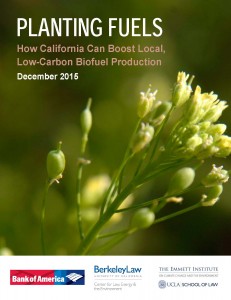 When we think of ways to reduce emissions from petroleum-based transportation fuels, electric vehicles get much of the headlines. Battery electric transportation certainly offers a viable, long-term alternative to petroleum fuels. But we’re still a few years away from an affordable, mass-market electric vehicle, and battery technology may be decades away, if ever, from being suitable for uses like long-haul trucking and aviation.
When we think of ways to reduce emissions from petroleum-based transportation fuels, electric vehicles get much of the headlines. Battery electric transportation certainly offers a viable, long-term alternative to petroleum fuels. But we’re still a few years away from an affordable, mass-market electric vehicle, and battery technology may be decades away, if ever, from being suitable for uses like long-haul trucking and aviation.
So what do we do in the meantime, if we hope to achieve California’s carbon reduction goals? Transportation, after all, is the single biggest source of greenhouse gas emissions in the state.
The response may in fact be growing all around us. Biofuels from agricultural sources like canola and corn, as well as algae, forest residue, and food waste, among others, can provide a low-carbon alternative to petroleum fuels, depending on its source and type. Certainly not all biofuels are environmentally beneficial, and one of the knocks on the federal Renewable Fuels Standard statute, with just-released new implementing rules from EPA announced on Monday, is that the law promotes biofuels that may actually be worse for the environment than petroleum fuels, given their production pathways and land use impacts.
But here in California, we have the opportunity to meet our climate goals while producing as much as half of our biofuels from low-carbon, in-state sources. To suggest policies that could boost this in-state production, UC Berkeley and UCLA Law are today releasing a new report “Planting Fuels: How California Can Boost Local, Low-Carbon Biofuel Production.” The report is the 16th in the two law schools’ Climate Change and Business Research Initiative, generously supported by Bank of America since 2009.
While California has a small but growing amount of biofuel production and consumption, federal and state leaders could do more to boost low-carbon, innovative biofuels. These leaders could:
- Provide greater support for in-state biofuel production, taking into account the full range of local biofuel carbon benefits and co-products, like biochar compost that can sequester carbon and thin-film plastic to bed strawberries and tomatoes;
- Offer financial incentives for automakers and gas stations to allow and sell greater amounts of low-carbon biofuels and higher blend rates; and
- Improve access to and financial support for in-state feedstock production, particularly on idled farmland and forest lands to reduce wildfire risks.
With these steps, California could power our cars, trucks and airplanes in a more environmentally beneficial manner, while boosting local economies in the process.
To learn more about the report and its recommendations, please join us for a webinar on December 14th from 11am to noon. Speakers will include:
- Tim Olsen, energy and fuels program manager at the California Energy Commission
- Lisa Mortenson, chief executive officer at Community Fuels
- Mary Solecki, western states advocate for Environmental Entrepreneurs
You can register via this site. We hope you can join for further discussion on this important topic.
BP isn’t exactly synonymous with clean and green energy, given the oil blowout in their Deepwater Horizon rig in the Gulf of Mexico back in 2010. But their analysis of the future of green energy is pretty positive [PDF]. As Greenbiz summarizes:
Bringing together previously internal analysis from BP’s energy experts, the document predicts the world will have a plentiful supply of affordable energy through the next few decades thanks to advances in all forms of energy technologies — from battery storage innovations to better extraction techniques for oil.
BP predicts the global energy system will remain heavily reliant on fossil fuels for decades to come. However, it also envisages strong growth potential for clean energy systems and supporting technology such as battery storage and electric vehicles.
What struck me among the five key points was #3, regarding the need for — and effect of — carbon pricing on future energy scenarios:
3. Carbon pricing will have a massive impact on competitiveness of renewables
Without a carbon price, gas and coal will remain the lowest-cost options for generating electricity in North America through 2050, according to the BP analysis. However, with the introduction of a relatively modest carbon price of $40 per tonne of CO2, new-build gas and renewables will start to displace coal.
With a higher carbon price — $80 per tonne of CO2 — onshore wind will be cost-competitive with natural gas by 2050, according to BP. This is based on analysis that applies a grid integration cost to renewables because of their intermittent energy supply.
This conclusion points to the importance of the international talks in Paris next month, where for the first time international negotiators may finally agree to even a modest floor on carbon pricing worldwide. We’ll need it as something to build on, while subnational entities like California and more progressive nations move forward to implement their own carbon pricing, either through cap-and-trade or direct taxes.
It’s on, and we’re up against global warming. Energy storage is the critical clean technology piece to decarbonize the grid (at least without nuclear power). The good news is that innovation is really taking off, now that the market for storage is clearer, with more renewables and electric vehicles.
From the San Francisco Chronicle:
In October, an international team of scientists announced a breakthrough in overcoming major obstacles in next generation energy storage and creating a battery that has five to 10 times the energy density of the best batteries on the market now. In September, Whitacre won a $500,000 invention prize for his eco-friendly water-oriented battery. And in April, Elon Musk announced plans for his Tesla Motors to sell high-tech batteries for homes with solar panels to store electricity for night time and cloudy day use, weaning the homes off dirtier power from the burning of coal, oil and gas.
“The pace of innovation does seem to be accelerating,” said JB Straubel, chief technical officer and co-founder of Tesla with Musk. “We’re kind of right at the tipping point where the current performance and lifetime of batteries roughly equal that of fossil fuels. If you are able to double that, the prospects are huge.”
Some of these breakthroughs will take years to commercialize, but at least we know in the near-term that lithium ion battery costs are coming down about 8-10 percent a year. Bottom line: lots of changes will happen on both the grid and in vehicles with these innovations.
And it can’t come soon enough.
The Volkswagen emissions cheating scandal is another sad example of corporate malfeasance. For those not following the story, the basics are as follows: Volkswagen secretly installed “defeat devices” on approximately 11 million vehicles worldwide that could detect when the cars were being tested for emissions and then reduce the emissions to avoid being penalized. While the vehicles performed well during laboratory testing, in reality the emissions were up to 40 times the legal limit. You can see the map of affected areas from the pollution via Grist here.
So what remedies should California, as the state most immediately affected, seek from VW? At a minimum, state leaders should use the opportunity to bolster reduced emissions from vehicles going forward. And that means improving the deployment of battery electric technologies in vehicles.
California has gone down this path before. When Enron and other energy companies defrauded electricity ratepayers with the rolling black-outs in California back in 2000 and 2001, the state eventually settled with NRG, the corporate entity that assumed the liability through corporate acquisitions. State negotiators required that NRG spend $100 million on electric vehicle charging infrastructure.
But that settlement has so far not worked out well. NRG is way behind schedule and state auditors are investigating what’s going on. So state leaders need to learn from that experience and find a more direct way for VW to pay for its malfeasance and pollution.
A relatively simple way to do it would be to require VW, via settlement terms, to purchase a set amount of “zero emission vehicle (ZEV)” credits from automakers making battery electrics. That would boost their supply and reduce the costs of electric vehicles. Or VW could pay into a fund that reduces the cost of purchasing or leasing electric vehicles, via a point-of-sale cash rebate, for example. And to be clear, these requirements should not be the only settlement terms, but the ones directly related to repairing the harm to the environment from this cheating.
Of course, we have years of litigation to come on this scandal. But state leaders should start thinking now about how to make some lemonade out of these bitter VW lemons, while learning from past experiences.

